Northwest Coast Energy News continues on hiatus as an archive of the energy, pipelines and LNG debates from 2011 to 2019.
It can and will be reactivated as news warrants.
Energy, environment and science in northwest British Columbia
Northwest Coast Energy News continues on hiatus as an archive of the energy, pipelines and LNG debates from 2011 to 2019.
It can and will be reactivated as news warrants.
An international team of scientists have identified a new species now called “the mesoamerican pine beetle” that is causing “catastrophic” damage to forests across Central America.
The new species, Dendroctonus mesoamericanus, works in concert with its cousin, the southern pine beetle, Dendroctonus Frontalis. Both are responsible for damage to pines, according to the United States Department of Agriculture.

Bark beetles of the genus Dendroctonus rank high among the most destructive conifer pests. The mountain pine beetle has destroyed forests across British Columbia and is now moving into Alberta.
The USDA says attacks “attributed to the southern pine beetle has led to declines in pine forests and multimillion dollar losses in timber, recreation, and other ecosystem services,” in Mexico, Belize and other countries in Central America.
As far back as 2002, scientists suspected, but could not confirm, that the problems in Central America were caused by two different pine beetles. From early 2000 to 2002, 25,000 hectares of mature pine stands in the Mountain Pine Ridge Forest Reserve of Belize were devastated by an outbreak of what was initially identified as the southern pine beetle. At the time the scientists investigating the outbreak suspected the trees were also infested by a second insect that they then called the “caribbean pine beetle.” However, there was insufficient evidence at the time to warrant scientific publication.
Between 2006 and 2010, Brian Sullivan, an entomologist with the USDA, and his colleagues, conducted studies on the pheromone and body wax chemistry of the beetle. Those studies provided clear biological evidence that it was a species new to science. Extension and forest health education programs in the Central American region have already begun to include information on the mesoamerican pine beetle.
“We found in research with our cooperators in Mexico and Norway that insects previously identified as southern pine beetles are actually two different species — southern pine beetle and the newly identified mesoamerican pine beetle,” said Sullivan. “The new species is nearly indistinguishable from the southern pine beetle. The two species appear to work in cooperation to kill trees, and outbreaks by both may be more persistent and destructive than those by southern pine beetle alone.”
Southern and mesoamerican pine beetles do differ in several respects. The mesoamerican adults tend to be somewhat larger than the southern pine beetle, and the holes where they enter the tree’s bark exude more resin, producing bigger “pitch tubes.”

Field observations suggest that the new species attacks trees shortly after southern pine beetle, colonizing the lower trunk and branches. The mesoamerican pine beetle also has a distinct pheromone chemistry and does not respond to traps baited with southern pine beetle lures.
Researchers have found mesoamerican pine beetles attacking eight species of native Central American pines and have collected the insect from Belize, southern Mexico, in Oaxaca, and Chiapas states, in Guatemala, El Salvador, Honduras, and Nicaragua. In these countries, the species has been collected at elevations from 311 to 2600 metres.
“A thorough understanding of this species complex – the southern and mesoamerican pine beetle acting in concert — may prove critical for developing integrated pest management strategies for the Central American region,” said Sullivan. “This discovery also brings to light a potential exotic threat to the U.S. that was not previously known to exist.”
Initial observations may indicate that the mesoamerican pine beetle is not as aggressive as the southern pine beetle, but may take advantage of trees infested by the southern pine beetle, making things worse.
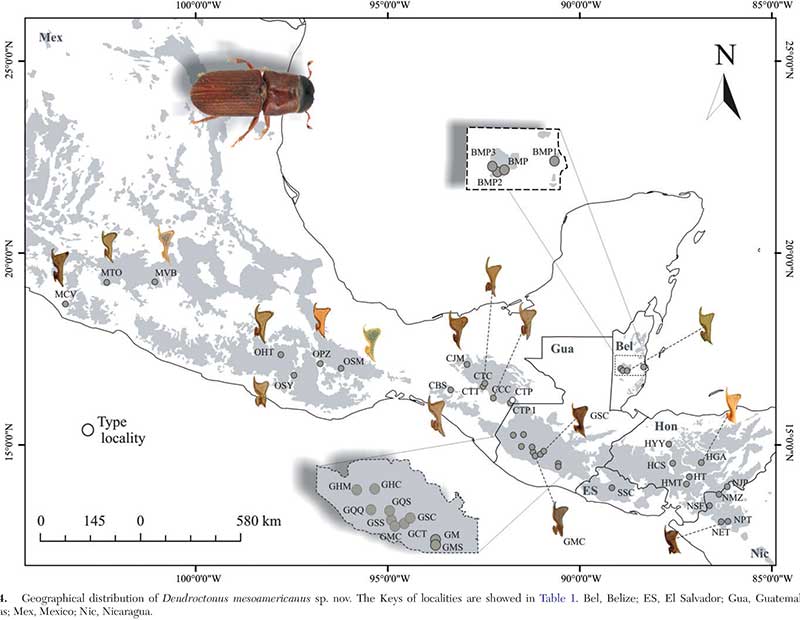
Authors of the description paper in Annals of the Entomological Society of America include Dr. Brian Sullivan, research entomologist with the Forest Service Southern Research Station, Francisco Armendariz-Toledano, graduate student with the Instituto Politecnico Nacional (IPN) in Mexico City; Dr. Gerardo Zuniga of IPN, Dr. Lawrence Kirkendall of the University of Bergen, Norway, and Alicia Nino, graduate student at El Colegio de la Frontera Sur (ECOSUR), Chiapas, Mexico.
Access the full text of the journal article: http://www.srs.fs.usda.gov/pubs/47987
The long awaited Kitimat air shed study, released by the province Friday, July 17, 2014, says “that with proper management, Kitimat’s ai rshed can safely accommodate new industrial growth” without major affects on either human health or the environment.
Link to news release : Study shows Kitimat airshed can handle new industrial development
The Kitimat Airshed Assessment looked at the cumulative effects of industrial air emissions, primarily sulphur and nitrogen oxides, and their potential impacts on both human health and the environment from
The study was divided into two zones.
Health results were first examined for Kitimat townsite, the Kitimat Industrial Service Centre and Kitamaat Village.
The wider study included Gitga’at Old Town, Hartley Bay (Kulkayu), Kitimat-Stikine, Kitselas, Kitsumkaylum, Kshish, and Terrace.
Enbridge missing
There was one big factor missing from the study, it does not include the Enbridge Northern Gateway project, although the consultants who did the study do cite a couple of the air quality studies that Enbridge filed with the Northern Gateway Joint Review Panel. That despite the fact the Joint Review Panel under Condition 82 required that Enbridge file with the NEB for approval, at least four months prior to commencing construction, “an Air Quality Emissions Management and Soil Monitoring Plan for the Kitimat Terminal.”
The JRP report acknowledged that emissions from the Enbridge terminal would be minimal but would contribute to the cumulative effect of pollutant emissions from other industries and required Enbridge to consult with the District of Kitimat, the environment ministries and other industries in planning for emissions.
The map from the airshed study also shows that the possible marine terminal for David Black’s proposed Kitimat Clean refinery project is at or close to where the proposed Enbridge Northern Gateway terminal would be.
Health and environment
The study looked at proposed emission levels and the effect of emissions elsewhere in the world and then compared those studies with the Kitimat Valley. It found that the risk of sulphur dioxide was “directly related to proximity to industrial area”–largely the Kitimat Service Centre area–and that there would be a minor increase in respiratory incidents of 0.5 per cent to 2 per cent, with a slight increase of nitrogen dioxide but those were within existing guidelines.
As for environmental impact, the study says nitrogen dioxide impacts will be low. There wil be “some increased risk of soil impacts” from sulphur dioxide. The study says there will be “no negative impacts to vegetation across all scenarios” but did find “potential for acidification” of seven small lakes. Lakelese Lake is not one of those affected.
The study also doesn’t include particulate matter and although it does consider climate change, did not take into consideration possible increase of green house gases in the Kitimat Valley.
The consultants, Esssa Technologies of Vancouver, based its findings on an earlier study by Rio Tinto Alcan on emissions from the Kitimat Modernization Project and worked on those findings by adding new industries and a greater area to the models they used.
The province and industry says they will continue to monitor air, water, soil and vegetation “to ensure these values are protected.”
The higher levels of sulphur dioxide emissions from the Rio Tinto Alcan Kitimat Mondernization Project will be allowed to continue under the current permit. Environment Minister Mary Polack told reporters that will only change if the current court challenge to the sulphur dioxide levels are successful.
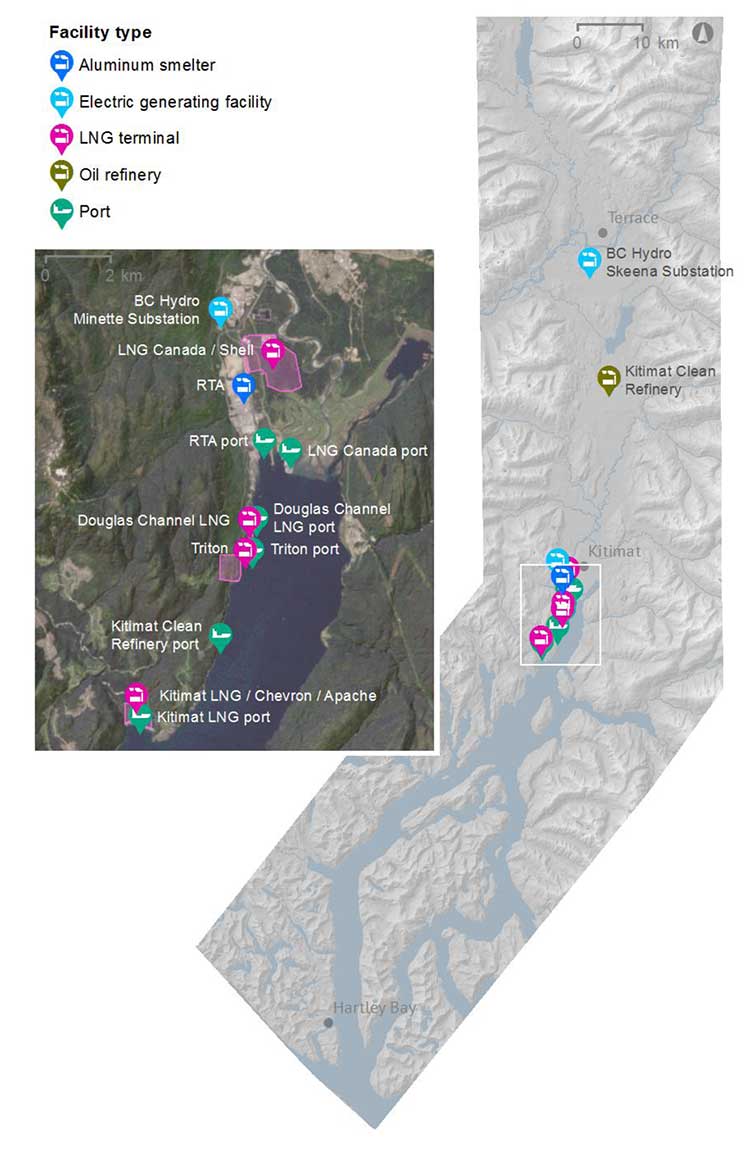
| What Northern Gateway Joint Review said about emissions in the air shed | |
| Among the 209 conditions imposed on the Enbridge Northern Gateway project is No. 82, an Air Quality Emissions Management and Soil Monitoring Plan.
Northern Gateway must file with the NEB for approval, at least 4 months prior to commencing construction, an Air Quality Emissions Management and Soil Monitoring Plan for the Kitimat Terminal…
One of the things that the Joint Review Panel noted in requiring Enbridge Northern Gateway to have an updated plan and to collaborate with Kitimat and other industries is that levels of acceptable sulphur doixide in the atmosphere are changing and much of Northern Gateway’s modelling was based on standards that were becoming obsolete. In the Joint Review Panel report, section 8.7, the JRP said:
The provincial air shed report considered only two contaminants, sulphur dioxide and nitrogen dioxide. Northern Gateway said there would be minimal atmospheric emissions from the construction and operation of the pipeline. The focus was on the Kitimat marine terminal.
Northern Gateway said there “no exceedances of hazardous air pollutant guidelines were predicted as a result of the project itself” but there could be a cumulative effect with other industries in the Kitimat waterfront. The Joint Review Panel ruled:
|
Related
Kitimat air shed study raises more questions than it actually answers
Will BC be better off with the Northern Gateway project or without it?
The latest spin from Enbridge (at taxpayer cost) depicts the wholesome image of corporate lead, Janet Holden, committing to a better and safer pipeline. The message: we will meet the highest standards, trust me.
BUT The best predictor of future performance is past performance.
Too soon we forget the 2010 Michigan oil spill and the outrage of the American government and its citizens over Enbridgeʼs poor response time and inadequate reaction to the devastation of oil spilling from their pipeline into a tributary of the Kalamazoo River. The impact on human health and ecology of the river systems continues to date. In that year alone over 1 million US gallons of oil was spilled as a result of ruptures or other causes of Enbridge pipeline failures.
But perhaps, you think we have ironclad environmental regulations which will prevent an oil spill disaster on the proposed pipeline through BC. Not likely. Bill C 38 took care of those bothersome standards. And donʼt count on the Department of Fisheries to be watchdogs for the 209 conditions outlined in the NEB report. DOF quietly transferred the responsibility for environmental standards along the pipeline corridor to the National Energy Board just before Christmas.
So do you trust Jason Macdonald from the PMOʼs office when he says”Our government recognizes the importance of developing resources responsibly and sustainably and we will continue to ensure that Canada’s environmental laws and regulations are rigorous?”
More and more informed Canadians are beginning to connect the dots.
Sheri Plummer
Parksville BC
The Harper government is stalling on requests for better earthquake preparation on Haida Gwaii, according to the NDP MP for Skeena Bulkley Valley, Nathan Cullen.
Speaking to northwest reporters on Thursday, February 28, Cullen who is NDP House Leader, said: “The government has been stalling since November when we’ve been asking them to meet the communities and meet their demands for funding, because as we see more earthquakes come, the support hasn’t been there from the federal government.”
The Skeena Bulkley Valley riding includes Haida Gwaii which was hit by a major 7.7 magnitude earthquake on October 27, 2012. Haida Gwaii and the northwest coast was shaken with numerous aftershocks through the rest of October and November. The most recent were 4.3 magnitude aftershock on February 24 and 4.5 magnitude aftershock on February 25.
On January 5, 2013, another 7.5 magnitude earthquake struck near Craig, Alaska. That quake was also felt throughout northwestern BC.
Both big quakes prompted tsunami warnings.
“The communities have done their work,” Cullen said. “We’ve given the government three months now. Earthquakes continue to still happen,
“Rather than shedding tears if something goes wrong, the government should fix the problems. We know exactly where the funding can be coordinated and effective particularly in Haida Gwaii, there’s been a lot of work done on behalf of their communities especially by their municipal leaders.
“The federal government simply has to say yes, to meet with them, to find some of those funding solutions. This is not rocket science.
“Maybe because there aren’t earthquakes in Ottawa, the Harper government doesn’t seem to think these things are a concern to people. But they are. And let’s not wait until a tragedy happens before we start to make some moves.”
Cullen noted that the federal government had recently budgeted $680,000 for new LED lights for the communities on Haida Gwaii.
“I am not going to speak against the need to put LED lights in but’s obvious that the federal government’s priorities are not aligned with what’s actually needed on the ground. People have been calling for this for years. We’ve seen tsunami warnings before. And there’s some good and reasonable fixes.
“The role of the federal government emergency preparedness requires this,” Cullen said, but then he added that, “Now one thing to keep in mind is that this federal conservative government wants to get out of anything to do with emergency readiness and response,” pointing to cutbacks in the budget for First Nations police forces.
Unmentioned at the news conference was that likely also includes the Coast Guard cutbacks on the west including, including the highly unpopular and controversial closing of the Kitsalano Coast Guard base in Vancouver
Cullen said he was hoping to meet with the cabinet ministers responsible to get more action on earthquake readiness on Haida Gwaii.
Related:
After the earthquake: Kitimat must immediately upgrade its emergency communications
Oct. 28, 2012
The tsunami, Twitter and the Zones: Did social media amplify government generated confusion?
Nov. 4. 2012
DFO study on ancient Douglas Channel tsunamis shows minimal impact on Kitimat, devastation at Hartley Bay
Nov. 17, 2012
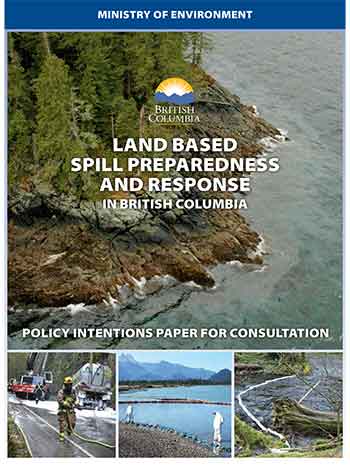 Residents of British Columbia have just two days to file information and opinions on the province’s plans for “options for strengthening BC’s spill preparedness and response policies and capacity.”
Residents of British Columbia have just two days to file information and opinions on the province’s plans for “options for strengthening BC’s spill preparedness and response policies and capacity.”
A page on the BC Ministry of the Environment’s web site wants public input as part of “BC’s five conditions necessary for support of heavy oil projects.”
Premier Christy Clark announced her controversial five conditions for pipeline development in BC in July 2012. Clark’s announcement was aimed both at the Northern Gateway Pipeline which would have its terminal in Kitimat, and the proposed Kinder Morgan pipeline expansion which has its terminal in Vancouver.
It is not clear how long the web page has been up, but the call for input from the public has received little, if any, publicity. The deadline for public submissions is February 15, 2013.
(Northwest Coast Energy News was alerted to the story by a Kitimat-based hiking club)
A separate call for academic papers had a deadline of January 25. The province plans a conference on oil spill response in Vancouver from March 25 to March 27. The website says”
As part of British Columbia’s commitment to a world leading preparedness and response regime for land based spills, it is hosting a symposium March 25-27, 2013 in Vancouver, BC. Due to the anticipated high interest in the symposium, attendance is by invitation only.
One question would be if invitation only is designed to exclude activist groups who may wish to participate or demonstrate. The Northern Gateway Joint Review panel banned public input at hearings in Vancouver and Victoria earlier this year to try, not always successfully, to head off demonstrations. The webpage says:
In keeping with the established polluter-pay principle, and recognizing the increase in development activities across the province, the Ministry of Environment (the ministry) is reviewing industry funded options for strengthening BC’s spill preparedness and response policies and capacity. Land based spill refers to any spill impacting the terrestrial environment, including coastal shorelines, regardless of the source.
This review addresses three aspects of land based spill preparedness and response: World leading regime for land based spill preparedness and response
Effective and efficient rules for restoration of the environment following a spill
Effective government oversight and coordination of industry spill response The ministry has developed a policy intentions paper for consultation (intentions paper) on the three aspects of the province’s land based spill preparedness and response regime under consideration.
The purpose of this intentions paper is to describe the ministry’s proposed policy direction and seek input on enhancing spill preparedness and response in BC. The intentions paper is a discussion document and your feedback will influence the policy approach.
Although the call for input is on the ministry website, the contact is a management consulting firm C. Rankin & Associates.
Chevron, which recently took over management of the Kitimat LNG project is advertising for a Houston, Texas, based logistics manager for the project.
The ad gives (in part) this job description:
Chevron is accepting online applications for the position of Kitimat Plant Logistics Manager located in Houston, TX through February 19, 2013 at 11:59 p.m. (Eastern Standard Time).
The Kitimat LNG project is located in Western Canada and includes 1) construction of the 2 x 5.5 MTPA Kitimat LNG Plant and 2) the Pacific Trails Pipeline.
Responsibilities for this position may include but are not limited to:
Responsibility for overseeing and managing the entire plant logistics program including module, equipment and bulk cargo logistics throughout the overall supply chain. Development of the necessary organizational capability within the Kitimat team, Engineering, Procurement & Construction (EPC) Re / Engineering, Procurement and Construction (Management) (EPCM) Contractor organization, and selected logistics contractors’ organizations
Assist in the development of contract ITB templates and scopes of work for project logistics contracts for (a) Heavy module marine/road transport and (b) General cargo transport from worldwide locations to module yards and Kitimat, freight forwarding services, and in-country transport, including development of criteria to evaluate bids.
Oversee the selected logistics contractors’ performance of project logistics, focusing primarily on the movement of prefabricated modules from multiple locations to ports near Kitimat.
Coastal First Nations have pulled out of the Joint Review hearings in Prince Rupert.
In a news release, Art Sterritt, executive director said:
This is a David and Goliath scenario, said Art Sterritt. “It seems the only party that can afford this long and extended hearing process is Enbridge and, perhaps, the Federal Government. The average citizen can’t afford to be here and the Coastal First Nations cannot afford to be here.”
Sterritt, the executive director of the Coastal First Nations, said pulling out was a difficult decision because the Emergency Response Panel is dealing with important issues. “We planned to ask questions that included: does diluted bitumen sink; how quickly can a spill be responded to and how effective can cleanup be; how long will spilled oil remain in the ecosystem and what are the costs of a spill cleanup and who will pay.”
It is clear that more scientific study is needed on emergency preparedness, he said. “Despite the lack of information it is continuing with the process. Ultimately this means the JRP will not have the information it needs to make an informed recommendation and that in turn means the Federal Government will be making decisions not based on science.”
The funding disparity isn’t the only JRP issue the Coastal First Nations is unhappy with. “We are dismayed with the nature of the hearing process itself. Enbridge witnesses are not answering questions or their answers are self-serving and non-responsive. We see cross-examination answers by Enbridge witnesses which are crafted with, or provided by, other persons sitting behind these witnesses who cannot be cross-examined. This does not seem fair to us at all.”
We had agreed to participate in this process on the basis that the JRP was going to be a decision-maker on whether or not the project would go ahead. Then the Federal Government unilaterally changed the decision-making process, he said. “This was blatantly unfair and smacks of double dealing – something we as First Nation have become accustomed to with this government.”
Coastal First Nations will continue to monitor these proceedings and we will do what we can to participate given our limited resources, Sterritt said. “We are profoundly disappointed with the nature of this process. Taken together these problems undermine the legitimacy and authenticity of the hearing process, our pursuit of the true facts and, ultimately, a just result.”
Other groups and individuals have also long complained about the growing expensive of travel and monitoring costs for the Joint Review process.
With temperatures climbing from climate change, the mountain pine beetle is now moving to higher elevations on mountain slopes, and is a “rising threat” to the whitebark pine, according to a University of Wisconsin-Madison study published today, Dec. 31, 2012, in the Proceedings of the National Academy of Sciences.
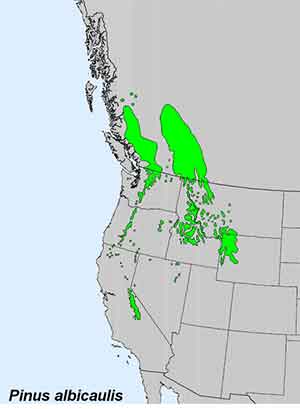
The whitebark pine is found mainly in the Rocky Mountains and Coast Range of British Columbia and into the northern United States.
In the US, there there have been a number of studies of pine beetle infestation of the whitebark pine. In 2011, the Seattle Times reported
A study in the mid-2000s showed whitebark trees had declined by 41 percent in the Western Cascades. Tree declines throughout Washington and Oregon hovered around 35 percent. In the coastal range and the Olympics, blister rust infection ranged from 4 to 49 percent. Nearly 80 per cent of the whitebark in Mount Rainier National Park are infected. Whitebark deaths in North Cascades National Park doubled in the last five years.
The Seattle Times also quoted the U.S. Fish and Wildlife Service reporting in 2007 that beetles killed whitebark pine trees across half a million acres in the US West — the most, at the time, since record-keeping began. Two years later, beetles killed trees on 800,000 acres.
Ken Raffa, a University of Wisconsin -Madison professor of entomology and a senior author of the new report says.”Warming temperatures have allowed tree-killing beetles to thrive in areas that were historically too cold for them most years. The tree species at these high elevations never evolved strong defenses.”
A warming world has not only made it easier for the mountain pine beetle to invade new and defenseless ecosystems, the scientists say, but also to better withstand winter weather that is milder and erupt in large outbreaks capable of killing entire stands of trees, no matter their composition.

“A subject of much concern in the scientific community is the potential for cascading effects of whitebark pine loss on mountain ecosystems,” says Phil Townsend, a Univeristy of Wisconsin-Madison professor of forest ecology and a senior author of the study.
The mountain pine beetle’s historic host is the lodgepole pine, and it was widespread lower elevations until the pine beetle infestation began to spread in the late 1990s. The pine beetle which are about the size of a grain of rice, played a key role in regulating the health of a forest by attacking old or weakened trees and fostering the development of a younger forest after the older trees died or were destroyed by fire.
However, recent years have been characterized by unusually hot and dry summers and mild winters, which have allowed insect populations to boom. This has led to an infestation of mountain pine beetle described by the scientists as “possibly the most significant insect blight ever seen in North America.”
A BC government report A History of the Battle Against the Mountain Pine Beetle 2000-2012 says:
Over most of the Interior, extreme winter weather (colder than minus 35 Celsius for at least several days or even weeks) historically killed most of the pine beetle population, limiting the duration of, and damage from, periodic epidemics. Such a wide-spread weather event has not occurred in the B.C. Interior since the winter of 1995/96.
The lodgepole pine co-evolved with the bark beetle, ad so it evolved chemical countermeasures, volatile compounds toxic to the beetle and other agents that disrupt the pine bark beetle’s chemical communication system.
According to the Wisconsin study, despite that robust chemical defense system, the lodgepole pine is still the preferred menu item for the mountain pine beetle, suggesting that the beetle has not yet adjusted its host preference to whitebark pine. “Nevertheless, at elevations consisting of pure whitebark pine, the mountain pine beetle readily attacks it,” says Townsend.
The good news, he adds, is that in mixed stands, the beetle’s strongest attraction is to the lodgepole pine, suggesting that, at least in the short term, whitebark pine may persist in those environments.
However, the 2007 US study quoted by the Seattle Times also warned that unlike lodgepole, whitebark pines produce few seed cones and do so late in life, so they “aren’t set up to survive massive slaughter.”
The new study, conducted in the Greater Yellowstone Ecosystem, also showed that the insects that prey on or compete with the mountain pine beetle are staying in their preferred lodgepole pine habitat. That, says Townsend, is a concern because the tree-killing bark beetles “will encounter fewer of these enemies in fragile, high-elevation stands.”
Whitebark pine trees are an important food source for wildlife, including black and grizzly bears, and birds such as the Clark’s nutcracker named after the famed explorer and which is essential to whitebark pine forest ecology as the bird’s seed caches help regenerate the forests.
(According to Wikipedia Clark’s Nutcrackers each cache about 30,000 to 100,000 each year in small, widely scattered caches usually under 2 to 3 centimetres of soil or gravelly substrate. Nutcrackers retrieve these seed caches during times of food scarcity and to feed their young. Cache sites selected by nutcrackers are often favorable for germination of seeds and survival of seedlings. Those caches not retrieved by time snow melts contribute to forest regeneration. Consequently,Whitebark Pine often grows in clumps of several trees, originating from a single cache of 2–15 or more seeds. Douglas Squirrels cut down and store Whitebark Pine cones in their middens. Grizzly Bears and Black Bears often raid squirrel middens for Whitebark Pine seeds, an important pre-hibernation food. Squirrels, Northern Flickers, and Mountain Bluebirds often nest in Whitebark Pines, and elk and Blue Grouse use Whitebark Pine communities as summer habitat. )
The BC government report says the pine beetle epidemic has now killed an estimated 710 million cubic metres of commercially valuable pine timber, 53 per cent of all such pine in the province. The rate of damage has been slowing for several years, but is projected to grow to 58 per cent by 2017 (to 767 million cubic metres).
Both the provincial and federal governments have spent hundreds of millions of dollars on the mountain pine beetle epidemic, beetle killed pine forest is more vulnerable to forest fires, and it is possible that the drier wood from beetle killed wood is responsible for the explosions at mills in Burns Lake and Prince George.
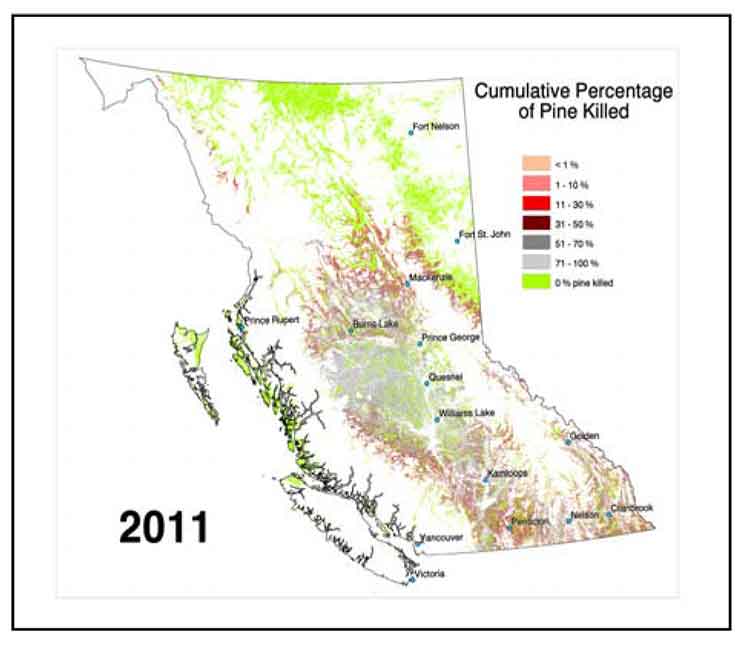
The BC government report says
B.C. has been battling the mountain pine beetle epidemic since the year 2000. From 2001 through 2004, the focus was on limiting the spread of the infestation and harvesting infested and susceptible pine stands. Not content to wait for frosts and winter cold spells that normally control the beetle, the Province took other steps to control the beetle’s spread. However the infestation continued to spread dramatically to 2007.
Throughout last decade, government and industry concentrated on salvage harvesting, to recover maximum economic value, and the reforestation of the dead stands. The provincial and federal governments invested hundreds of millions of dollars in mitigating the infestation’s impacts, in developing new markets for beetle-killed lumber, and in creating economic strategies for the future.
At the same time, the forest industry invested in adapting its harvest and milling technologies to the ever-changing forest resource, using the knowledge and experience gained from a significant, but much smaller, beetle infestation that hit the Cariboo-Chilcotin in the mid-1980s.
These actions have placed the industry, government and communities in the best position to address the next phase of the epidemic, as harvest and milling activities inevitably start declining.